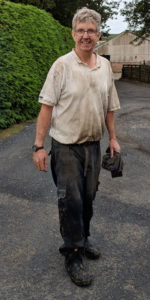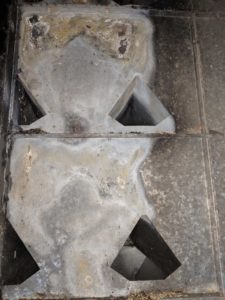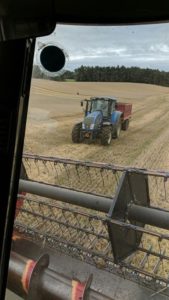Last year I was able to do a harvest report once a week, but due to weather conditions we haven’t actually done that much harvest since last time I wrote. There has, however, been lots of things going on that are worth talking about.
Grain Dryer Fire
Last time I wrote I said that work was still being done on getting the new elevators and conveyors put in at the grain dryer. Work was completed, and everything up and running on 10th August. We spent the next few days putting the winter barley through the dryer, and were starting to move it round to the grain store. By the middle of the following week we were up to date with the drying, but I left grain in the dryer as the burners were due to be serviced.
There are 3 diesel fired burners in our grain dryer which I get serviced once a year, but because work had been ongoing I had delayed it. The engineer arrived just after lunch time on Wednesday, and cleaned all 3 burners. Now, normally we only run with 2 burners at a time but because we were testing all 3, I turned the temperature up, and we had all 3 burners going. Everything checked out fine, and I switched the burners off, leaving the fans on to let the dryer cool down. That’s when the fun started. We started to smell smoke, and there was smoke coming out of one of the exhaust pipes of the dryer.
I called for the fire brigade almost immediately, and started unloading the grain in the dryer as fast as I could. The dryer holds approximately 16 tonnes of grain, and I reckon I had about half of it out when the unloading mechanism stopped…
The fire brigade were here with 2 units within about 20 minutes, and by this time we could see which part of the dryer was on fire, as the metal was glowing red, and the odd flame was licking out from it.

They had the fire out within a few minutes, but we still had to get the dryer emptied so they could make sure it would not flare up again.
To cut a long story short, I had to get Stuart from Sellars out to help me clear the dry grain elevator, and Andy from Anderson’s Electricians to see if he could get the unloading mechanism working again. Thankfully he could, and we had the dryer emptied within half an hour. This enabled the fire brigade to dampen down any other hotspots they found, and everything was back under control.
It was 7.00pm at this point. I was soaked, black and blue, and my back was killing me, but I was so relieved that we’d caught it before it got well out of control.

The next few days were spent clearing up the mess, speaking to NFU Mutual (our insurers), and waiting on new parts, but by Wednesday this week we were back up and running again. We only lost 9 tonnes of grain due to smoke or fire damage, which was lucky to say the least.
I can only surmise that a spark from one of the burners hit a pocket of dust, which combined with the higher temperature, ignited.

Harvest Fever and Bare Ground Syndrome
Harvest Fever and Bare Ground Syndrome (BGS) are undocumented medical conditions that affect all arable farmers, and I’m sure some gardners as well. They both occur in late summer/early autumn, and early symptoms are twitching, restlessness, and continually looking at the weather forecast. I will deal with Harvest Fever first.
Harvest Fever
Harvest fever usually happens when a neighbour’s combine is seen to be working when yours is not. You may have a perfectly good reason for not combining, but that is irrelevant. The affected farmer will spend time rushing round his crops checking to see if there is anything fit to cut, and if so, the combine is rushed out to make a start. I suffered a minor case myself last week.
We had had a good day combining on the Friday, and there had been rain overnight. The weather during the morning had been cloudy, and things were not drying out, so I (correctly I thought) decided that there was little or no chance of combining. I had some errands to do in St. Andrews, which is about 10 miles away from me, so late afternoon I set off.
After about 3 miles I noticed that the sun was appearing, and shortly after that I passed my first combine. It was cutting wheat in a field next the road. “It’s OK, they’ve had sun here, which we’ve not had” I told myself as I drove on. After a further 4 miles I passed a second combine, also cutting wheat, in brilliant sunshine. I began to feel uncomfortable. Just outside St Andrews I passed a third combine, and well, that was just too much.

I literally flew round my errands, shot back home, and Cameron and I went and cut some barley. Was it fit to cut? Probably. I don’t care. I felt better at having done something…
Bare Ground Syndrome (BGS)
Like all good farmers, we plan a crop rotation of sorts. We set out a rough plan before harvest of what we are going to grow, and where. It is only a rough plan, as the weather can greatly influence things, but BGS is something that has to be watched for. BGS tends to appear where a field has been cleared of its crop, the weather is good, and the farmer has time on his/her hands. It tends to afflict the older generation of farmers worse, as they were farming at a time where every scrap of land had to be productive, but it can afflict the younger generation too if they are not careful. You get the same twitching and restlessness as with harvest fever, but this time it is because the farmer feels they’ve GOT_TO_GROW_SOMETHING!!! Economic and rotational rationale goes completely out the window as there is a compulsion to get a crop in that bare ground. When confronted with what is happening the affected farmer is able to come up with a myriad of plausible reasons as to why it is a good idea, and a firm hand is required to convince him of what is actually happening.
Back to the Future
Two years ago we decided to stop growing Oilseed rape. The main reason was that it wasn’t really making money, but it also tended to put us under extra pressure in August, when it was sown. Oilseed rape is a difficult crop to establish, and weed control can be a real problem. I can honestly say we’ve not regretted the decision since then.

This year we have sown 35 acres of oilseed rape… but the ground was in perfect condition for establishing rape, we picked a variety that gives us greater flexibility for weed control, and we used a contractor to do all the work!!
Oilseed Rape Establishment
Under normal circumstances we would plough ground before sowing a crop. Ploughing buries all the weeds, trash and rubbish and gives the new crop a good start, but the biggest problem with it is it takes time. The alternative is what is known as ‘minimum tillage’, or min-till for short. Here only the top 5 – 10cm of the soil is cultivated and the crop is sown. The theory is that by not inverting the soil you are keeping the natural drainage channels open, and also all the worm activity is undisturbed, so you are improving the soil structure where it matters. Generally speaking we are unconvinced by most of these arguments, but because it is so much faster than ploughing and if the conditions are right, then we will use it.

From the pictures you will see there is some straw or stubble left on the top. The field is a light sandy field, which means that if it dries out and a wind gets up, then the sand will blow. If the young seedlings are newly emerged when this happens, then they get stripped out. The straw/stubble on the top gives them a bit more protection, which is an added benefit over ploughing.
Harvest Progress
We finished the winter barley on the 4th of August, and it was a reasonable crop considering the year. Due to the poor weather we didn’t get any spring barley cut until the 17th of August, and only got the one day and a bit. The fields we have cut so far are both sandy, so suffered with the drought this summer. The crop has not been good. The barley was destined for malting, but the grain nitrogen levels were high, at 1.71. In a normal year, the maximum allowed is 1.65, but because of the year nitrogen levels are high generally so the tolerance has been raised to 1.75 in some circumstances, and this may be raised higher at a later date as the full picture of Scottish crop quality becomes clear.
Grain prices are holding up very well, which will make up for the poorer crop, and as suspected there is very little straw.


Jim, This all sounds very technical. I just enjoyed the poppies mixed with the rape a few years ago and wondered why you haven’t done it again!
Angus, unfortunately a field of poppies won’t pay the rent…